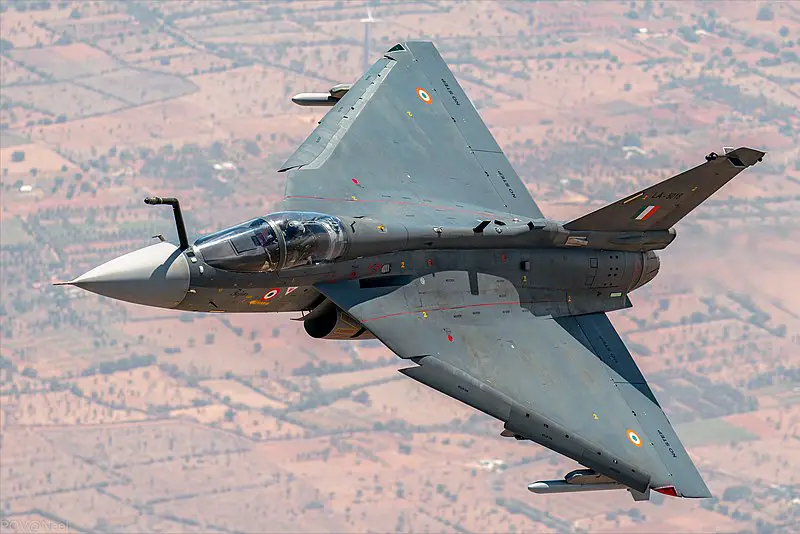Breaking news
Indian Air Force LCA Tejas fighter jets to be armed with JDAM guidance kit bombs.
According to India Today, indigenous LCA Tejas fighter jets will be armed with bombs fitted with U.S.-made JDAM guidance kits which would help the Indian Air Force target enemy positions with pinpoint accuracy. The emergency powers were given to the armed forces because of the ongoing conflict with the People’s Liberation Army of China in the Eastern Ladakh sector.
Follow Air Recognition on Google News at this link
 HAL Tejas (LA-5018) of Squadron 18 Flying Bullets (Picture source: Wikipedia)
HAL Tejas (LA-5018) of Squadron 18 Flying Bullets (Picture source: Wikipedia)
India has placed orders for American Joint Direct Attack Munition (JDAM) precision-guided bombing kits to enhance the capabilities of its Tejas Light Combat Aircraft. The acquisition of JDAM kits under delegated financial powers by the Air Force will enable Tejas jets to take out enemy bunkers and runways at 80 km and distances beyond, India Today writes. It would enable the Tejas to carry out Balakot-like airstrikes with more accuracy and precision.
India has already activated two LCA Tejas fighter squadrons and is looking to get four more in a couple of years. They will replace the outgoing MiG-21 inventory. “LCA Tejas is a far better aircraft than the Chinese developed JF-17 and the HAMMER would take it ahead of their fleet in strike capabilities,” an official said, echoed by India Today.
Tejas Light Combat Aircraft
The HAL Tejas is a multirole light fighter designed by the Aeronautical Development Agency (ADA) in collaboration with Aircraft Research and Design Centre (ARDC) of Hindustan Aeronautics Limited (HAL) for the Indian Air Force and Indian Navy. It came from the Light Combat Aircraft (LCA) programme, which began in the 1980s to replace India's ageing MiG-21 fighters but later became part of a general fleet modernisation programme. In 2003, the LCA was officially named "Tejas". It is the smallest and lightest in its class of contemporary supersonic combat aircraft.
The Tejas is the second supersonic fighter developed by HAL after the HAL HF-24 Marut. The Tejas achieved initial operational clearance in 2011 and final operational clearance in 2019. The first Tejas squadron became operational in 2016, as No. 45 Squadron IAF Flying Daggers was the first to have their MiG-21s replaced with the Tejas.
The Tejas currently has three production models: Tejas Mark 1, Mark 1A and the trainer variant. The IAF placed an order for 40 Tejas Mark 1 and 83 Tejas Mark 1A, including Tejas trainer aircraft. The IAF plans to procure 324 aircraft in all variants, including the Tejas Mark 2 developed by the HAL. The Tejas Mark 2 is expected to be ready for series production by 2026–27.
Joint Direct Attack Munition (JDAM)
The Joint Direct Attack Munition (JDAM) is a guidance kit that converts unguided bombs, or "dumb bombs", into all-weather precision-guided munitions. JDAM-equipped bombs are guided by an integrated inertial guidance system coupled to a Global Positioning System (GPS) receiver, giving them a published range of up to 15 nautical miles (28 km). JDAM-equipped bombs range from 500 pounds (230 kg) to 2,000 pounds (910 kg). The JDAM's guidance system was jointly developed by the U.S. Air Force and the U.S.Navy, hence the "joint" in JDAM. When installed on a bomb, the JDAM kit is given a GBU (Guided Bomb Unit) identifier, superseding the Mark 80 or BLU (Bomb, Live Unit) nomenclature of the bomb to which it is attached.
The JDAM is not a stand-alone weapon; rather it is a "bolt-on" guidance package that converts unguided gravity bombs into precision-guided munitions (PGMs). The key components of the system consist of a tail section with aerodynamic control surfaces, a (body) strake kit, and a combined inertial guidance system and GPS guidance control unit.
The JDAM was meant to improve upon laser-guided bomb and imaging infrared technology, which can be hindered by bad ground and weather conditions. Laser seekers are now being fitted to some JDAMs.
As of February 2020, Boeing had produced 430,000 guidance kits.


























